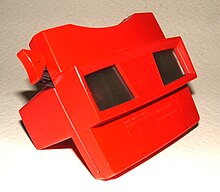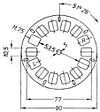View-Master
This article needs additional citations for verification. (December 2013) |

View-Master is the trademark name of a line of special-format stereoscopes and corresponding View-Master "reels", which are thin cardboard disks containing seven stereoscopic 3-D pairs of small color photographs on film.[1]
The View-Master system was introduced in 1939, four years after the advent of Kodachrome color film made the use of small high-quality photographic color images practical. Tourist attraction and travel views predominated in View-Master's early lists of available reels, most of which were meant to be interesting to users of all ages. Most current View-Master reels are intended for children.
History
1919–56: stereoscopic sightseeing
After serving in the U.S. Army in World War I, Edwin Eugene Mayer worked as a pharmacist at Owl Drug Store in downtown Portland, Oregon. He built up a photo-finishing business there, and in 1919, Edwin Mayer bought into Sawyer's Photo Finishing Service with the help of his father, August Mayer, Edwin's fiancee, Eva McAnulty and her sister, Vi McAnulty.
In a letter dated April 1, 1954, Ed Mayer described how he started the business, writing: "Suffice to say that in 1919, what little it was, was purchased with borrowed ($3,500.00) money from Dad, aided by about $1,600 in insurance money Eva got when her father died and which was left in permanently, and $1,600 borrowed from Vi and repaid, along with Dad's notes, within a few years."[2]
As the business grew, Ed Mayer incorporated in about 1926, taking on partners Harold and Beulth F. Graves, Thomas and Pauline Meyer and Augusta and Raymond F. Kelly, renaming the business Sawyer Service, Inc. The company relocated to a large two-story building at 181 Ella St., near Morrison Street in Portland, Oregon.[3]
In 1926, when Harold Graves joined Sawyer's, it was by then producing photographic postcards and album sets as souvenirs. Graves handled marketing for the products while Mayer ran the business. Later, photographic greeting-cards marketed to major department stores were added to the Sawyer's product line. Sawyer's was the nation's largest producer of scenic postcards in the 1920s and eventually, the future View-Master viewer would become an extension of the two-dimensional cards.
The company took the first steps towards developing the View-Master after Edwin Mayer and Graves met with William Gruber, an organ maker and avid photographer living in Portland. Mayer and Gruber had both developed devices for viewing stereo images. But Gruber had made up a stereo imaging rig out of two Kodak Bantam Specials mounted together on a tripod. He designed a machine that mounted the tiny pieces of Kodachrome color transparency film into reels made from heavy paper stock. A special viewer was also designed and produced. He had the idea of updating the old-fashioned stereoscope by using the new Kodachrome 16-mm color film, which recently had become available. While a View-Master disk holds 14 film slides, these really are only seven pairs, making up the seven stereoscopic image; two film slides are viewed simultaneously, one for each eye, thus simulating binocular depth perception.
According to a 1960 court document, the Gruber-Sawyer partner venture began from that first meeting in 1938. Thereafter, while production methods and some marketing were developed, Ed Mayer negotiated with Gruber. After three years, a formal agreement was entered into on February 24, 1942 between Gruber and Sawyer partners doing business as Sawyer's. Uncertain as to what to call their new product, Ed Mayer and people within the Sawyer’s organization eventually came up with the name "View-Master." (Even though the View-Master brand name would eventually come to be recognized by 65 percent of the world’s population, William Gruber hated the name Mayer gave it, thinking it sounded too much like Toast-Master, Mix-Master or some other kitchen appliance.)[4]
In late 1939, the View-Master was introduced at the New York World's Fair (marked "Patent Applied For"). It was intended as an alternative to the scenic postcard, and was originally sold at photography shops, stationery stores, and scenic-attraction gift shops. The main subjects of View-Master reels were Carlsbad Caverns and the Grand Canyon.[1]
The View-Master was marketed through Ed Mayer's photo-finishing, postcard, and greeting card company, Sawyer's Service, Inc. known eventually as Sawyer's, Inc. The partnership led to the retail sales of View-Master viewers and disks. The patent on the viewing device was issued in 1940, on what came to be called the Model A viewer. Within a very short time, the Viewmaster quickly took over the postcard business at Sawyer's.
In his April 1, 1954 letter, Ed Mayer gave details of the company's expansion. He wrote: "In 1939, 20 years after starting the business, we had, by dint of hard work and long hours and frugal living, accumulated a business (Sawyer's) worth about $58,000.00 and Western Photo Supply Co. owning the buildings, worth about $30,000.00. The above figures were for the total business and buildings owned by the Kellys, Graves, Mayers and Meyers. In 1946, we had already grown a lot from 1939, and Sawyer's made a lease with Western Photo Supply Co., they to build and lease two new buildings to Sawyer's, in addition to the two we already had. At this point, Sawyer's also decided to change its structure from a partnership to a corporation, for various good reasons, one of which was to permit our children to participate in the stock ownership." [5]
In the 1940s, the United States military recognized the potential for using View-Master products for personnel training, purchasing 100,000 viewers and nearly six million reels from 1942 to the end of World War II in 1945.[1]
After the development of the View-Master, Sawyer's, Inc. moved into the new building at 735 S.W. 20th Place in downtown Portland. The company also occupied a building next door at 740 S.W. 21st Avenue. Years later, Edwin Mayer and his Sawyer's partners purchased land in Washington County near Progress, Oregon, west of Beaverton, and built a large plant there in about 1951. The plant has since been removed and developed into a shopping center. After moving to the new plant, Mayer leased the old Sawyer's building on 20th Place to Oregon Television, Inc., KPTV, Channel 12.
In 1951, Sawyer's purchased Tru-Vue, the main competitor of View-Master. In addition to eliminating the main rival, the takeover also gave Sawyer's Tru-Vue's licensing rights to Walt Disney Studios. Sawyer's capitalized on the opportunity and produced numerous reels featuring Disney characters. The takeover would pay off further in 1955, with reels of the newly opened Disneyland.[1]

In 1952, Sawyer's began its View-Master Personal line, which included the View-Master Personal Stereo Camera for its users to make their own View-Master reels. Although at first successful, the line was discontinued in ten years. This line spawned the Model D viewer (available until the early 1970s, it was View-Master's highest-quality viewer) and View-Master's only 3-D projector, the Stereomatic 500.[1] The other projectors were 2-D and used only one of the images.
In 1955, the Model E was introduced, with a more modern design, big ivory buttons on the picture changer levers, and a large "V" slot on top for easier reel insertion. It was released in brown and black in the United States, and some other colors elsewhere.[6] It was about 4 inches high, 5 inches wide, and 4 inches deep.
In 1958, the Model F was introduced; it used C-cell batteries to power an internal lighting source.
Industrial designer Charles "Chuck" Harrison led the team designing the Model F View-Master. Fifty years later (in 2008) Harrison won the Cooper-Hewitt Lifetime Achievement Award. [7]

In 1962, the Bakelite models were replaced with plastic versions, the first of which was the Model G. This change was driven by Sawyer's new president, Bob Brost, who took over in 1959. The View-Master had been constructed originally from Kodak Tenite plastic and then Bakelite, a hard, sturdy, somewhat heavy plastic. The material of choice under Brost became the lighter thermoplastic.[1]
1966–present: stereoscopic toy
In 1966, Sawyer's was acquired by the General Aniline & Film (GAF) Corporation, and became a wholly owned subsidiary. Under GAF's ownership, View-Master reels began to feature fewer scenic and more child-friendly subjects, such as toys and cartoons. Television series were featured on View-Master reels, such as Doctor Who, Rowan & Martin's Laugh-In, Star Trek, The Man From U.N.C.L.E., Family Affair, Here's Lucy, and The Beverly Hillbillies. Actor Henry Fonda appeared in a series of TV commercials for the GAF View-Master.[1]
From 1970 to around 1997, there were versions of "Talking View-Masters," which included audio technology with the reels with three major designs with increasing sophistication.[8]
In 1998, EPA investigations began on View-Master factory supply well for the toxic chemical trichloroethylene (TCE). The plant was shut down in 2001.[9]
In March 2009, the Fisher-Price division of toy maker Mattel announced that they had stopped production in December 2008 of the scenic reels depicting tourist attractions. These reels of picturesque scenes and landscape scenery were descendants of the first View-Master reels sold in 1939. Fisher-Price announced they would continue to produce reels of animated characters.[10] In late 2009, Alpha-cine announced it would take-up the scenic reel production under an agreement with Fisher-Price.,[11]
Cumulative production and honor
There have been some 25 viewer models, thousands of titles, and 1.5 billion copies of reels. Despite its long history and many changes in models and materials, the same basic design of reels and internal mechanism remained, ensuring that every reel will work in every model.[1]
View-Master is part of the National Toy Hall of Fame of the United States.[12]
Film
As of July 2009, DreamWorks SKG was negotiating for the rights to develop View-Master into a feature film.[13]
Notable uses

Reels have been produced for Disneyland, many TV shows, movies (such as E.T. the Extra-Terrestrial, The Flying Nun and Jurassic Park), and the U.S. military (for airplane and ship identification and range estimation).
David L. Bassett, an expert on anatomy and dissection, collaborated with Gruber to create a 25-volume atlas of human anatomy using the View-Master system.[14]
View-Master produced custom reels for commercial customers to show 3-D images of products and services to potential clients. For example, in the early 1990s, Canadian restaurant chain East Side Mario's used a View-Master reel as their dessert menu.[15]
Among the newest View-Master products are a Discovery Channel View-Master, the new Virtual Viewer, the Discovery Channel View-Master Projector and Telescope, and the View-Master 3-D Pocket Viewer, which feature images of popular performers in concert and backstage.
See also
References
- ^ a b c d e f g h Mary Ann & Wolfgang Sell and Charley Van Pelt, "View-Master Memories" , M.A. and W. Sell, ISBN B0006S314I, 2000 Self-Published
- ^ Document written by Edwin E. Mayer, dated April 1, 1954, stating history of Sawyers, Inc. Published in the family history "The Morris and McAnulty Connection", by Peggy Savage, 2013, Canby, OR.
- ^ Document written by Edwin E. Mayer, dated April 1, 1954, stating history of Sawyers, Inc.
- ^ 285 F.2d 683 Eva R. MAYER, Executrix of the Estate of Edwin E. Mayer, deceased, Harold J. Graves and Beulah F. Graves, Thomas O. Meyer and Pauline Meyer, Augusta Kelly, and The Estate of Raymond F. Kelly, deceased, Augusta Kelly, Residuary Legatee, Appellants, v. UNITED STATES of America, Appellee. No. 16103.United States Court of Appeals Ninth Circuit. Dec. 9, 1960.
- ^ Document written by Edwin E. Mayer, dated April 1, 1954, stating history of Sawyers, Inc.
- ^ "View-Master Model E - Replacement for the Model C ViewMaster". viewmaster.co.uk. Retrieved 2014-02-08.
- ^ Jonathan Glancey (2008-07-31). "Classics of everyday design No 48: Jonathan Glancey on the View-Master | Art and design | guardian.co.uk". London: Guardian. Retrieved 2011-05-23.
- ^ Clatworthy, Keith. "Talking View-Master". 20th Century Stereo Viewers. Retrieved 12 December 2012.
- ^ "ATSDR-PHA-HC-View-Master Factory Supply Well-p1". Atsdr.cdc.gov. Retrieved 2011-05-23.
- ^ Doug Whiteman, View-Master 3-D travel reels head into the sunset, AP, March 2009
- ^ View-Master Custom and Scenic Reel Sales, viewmastercustomreels.com, Retrieved 2012-08-16.
- ^ Easy-Bake Oven. "National Toy Hall of Fame". Strongmuseum.org. Retrieved 2011-05-23.[dead link]
- ^ Borys Kit and Jay A. Fernandez. "DreamWorks Eyes View-Master Pic". DreamWorks Studios. Retrieved 2011-05-23.
- ^ Schwartz, John (2008-04-22). "The Body in Depth - New York Times". Nytimes.com. Retrieved 2011-05-23.
- ^ "The View-Master Ultimate Reel List - Commercial Reels". Retrieved 2012-08-12.
External links
- Official View-Master Site at Fisher-Price
- Vintage View-Master Hacked to Stereoscopy Player at 3D Stereoscopy Community

